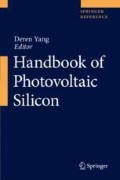Abstract
Producing upgraded metallurgical-grade silicon may be the most promising method to replace the modified Siemens process to produce solar-grade silicon, which has many advantages such as no pollution and low cost in the production process. The main process is described in detail, including smelting and secondary refining of metallurgical-grade silicon and acid leaching treatment. Other technologies also are introduced and discussed: solvent refining, vacuum treatment, plasma refining, and electron beam treatment; these technologies are used to refine metallurgical-grade silicon. Purification is also very important in the production process; a solidification process is used in purification to obtain highly pure silicon.
Access this chapter
Tax calculation will be finalised at checkout
Purchases are for personal use only
References
S.R. Bharadwaj, A.S. Kerkar, S.N. Tripathi, et al., J. Chem. Thermodyn. 22, 453–461 (1990)
Y. Dai, B. Yang (eds.), Nonferrous Metal Vacuum Metallurgy, 2nd edn. (Metallurgical Industry Press, Beijing, 2009)
R.H. Hopkins, A. Rohatgi, Impurity effects in silicon for high efficiency solar cells. J. Cryst. Growth 75, 67–79 (1986)
L. Hu, Z. Wang, X. Gong, Z. Guo, H. Zhang, Purification of metallurgical-grade silicon by Sn–Si refining system with calcium addition. Sep. Purif. Technol. 118, 699–703 (2013)
J.M. Juneja, G.N.K. Iyengar, K.P. Abraham, J. Chem. Thermodyn. 18, 1025–1035 (1986)
O. Kubaschewski, C.B. Alcock, Metallurgical Thermochemistry, 5th edn. (Pergamon Press, Oxford, 1979)
O. Kubaschewski, C.B. Alcock, wrote. Z. Qiu, Y. Liang, X. Li, et al., trans. Metallurgical Thermochemistry (Metallurgical Industry Press, Beijing, 1985), pp. 486–513.
Y. Lei, W. Ma, L. Sun, J. Wu, Y. Dai, K. Morita, Removal of B from Si by Hf addition during Al–Si solvent refining process. Sci. Technol. Adv. Mater. 17, 12–19 (2016)
Y. Liang, Y. Che (eds.), Inorganic Thermodynamics Data Sheet (Northeastern University Press, Shenyang, 1993)
N. Nakamura, H. Baba, Y. Sakaguchi, Y. Kato, Boron removal in molten silicon by a steam-added plasma melting method. Mater. Trans. 45(3), 858 (2004)
A. Schei, H. Rong, A.G. Forwald, Impurity distribution in silicon (Silicon for Chemical Industry, Geiranger, 1992), pp. 16–18
Y. Tan, X. Guo, S. Shi, W. Dong, D. Jiang, Study on the removal process of phosphorus from silicon by electron beam melting. Vacuum 93, 65–70 (2013)
K. Tang, E.J. Øvrelid, G. Tranell, M. Tangstad, Thermochemical and kinetic databases for the solar cell silicon materials, in The Twelfth International Ferroalloys Congress, Sustainable Future, Helsinki, 6–9 June 2010
K. Tang, S. Andersson, E. Nordstrand, M. Tangstad, Removal of boron in silicon by H2–H2O gas mixtures. J. Miner. Met. Mater. Soc. 64(8), 952–956 (2012)
K. Wei, W. Ma, B. Yang, D. Liu, Y. Dai, K. Morita, Study on volatilization rate of silicon in multicrystalline silicon preparation from metallurgical grade silicon. Vacuum 85, 749–754 (2011)
J. Wu, Y. Li, W. Ma, K. Liu, K. Wei, K. Xie, B. Yang, Y. Dai, Impurities removal from metallurgical grade silicon using gas blowing refining techniques. Silicon 6, 79–85 (2014a)
J. Wu, Y. Li, W. Ma, K. Wei, B. Yang, Y. Dai, Boron removal in purifying metallurgical grade silicon by CaO–SiO2 slag refining. Trans. Nonferrous Metals Soc. Chin. 24, 1231–1236 (2014b.) http://www.sciencedirect.com/science/article/pii/S1003632614631836
J. Wu, F. Wang, W. Ma, Y. Lei, B. Yang, Thermodynamics and kinetics of boron removal from metallurgical grade silicon by addition of high basic potassium carbonate to calcium silicate. Metall. Mater. Trans. B 47B, 1796–1803 (2016.) https://link.springer.com/article/10.1007/s11663-016-0615-z
J. Wu, Y. Zhou, W. Ma, M. Xu, B. Yang, Synergistic separation behavior of boron in metallurgical grade silicon using a combined slagging and gas blowing refining technique. Metall. Mater. Trans. B 48(1), 22–26 (2017.) https://link.springer.com/article/10.1007/s11663-016-0860-1
S. Zhang (ed.), Vacuum Technology Physical Basis (Northeast Institute of Technology Press, Shenyang, 1988)
Author information
Authors and Affiliations
Corresponding author
Editor information
Editors and Affiliations
Section Editor information
Rights and permissions
Copyright information
© 2019 Springer-Verlag GmbH Germany, part of Springer Nature
About this entry
Cite this entry
Ma, Wh., Wu, JJ., Wei, Kx., Lei, Y. (2019). Upgrade Metallurgical Grade Silicon. In: Yang, D. (eds) Handbook of Photovoltaic Silicon. Springer, Berlin, Heidelberg. https://doi.org/10.1007/978-3-662-56472-1_7
Download citation
DOI: https://doi.org/10.1007/978-3-662-56472-1_7
Published:
Publisher Name: Springer, Berlin, Heidelberg
Print ISBN: 978-3-662-56471-4
Online ISBN: 978-3-662-56472-1
eBook Packages: Chemistry and Materials ScienceReference Module Physical and Materials ScienceReference Module Chemistry, Materials and Physics

